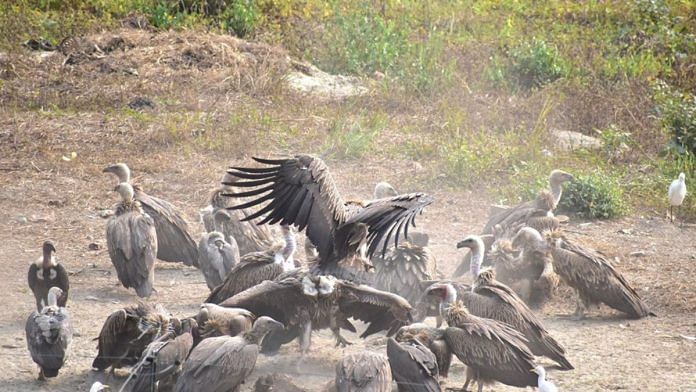Kolkata: The release of 20 vultures from Raja Bhat Khawa in West Bengal’s Buxa Tiger Reserve on 10 February is a landmark moment for wildlife conservation in India. The movement of these birds — 13 critically endangered Oriental white-backed vultures bred in captivity and seven rescued Himalayan griffons — is under constant surveillance as they are likely to fly around West Bengal, Assam, Meghalaya and toward Nepal, Bangladesh, and Bhutan.
All thirteen captive-bred white-rumped vultures are sub-adults fitted with satellite tags known as Platform Transmitter Terminal (PTT). The Himalayan vultures may go to their breeding areas in Central Asia, China or the high Himalayas. The next six months are crucial and will tell us how safe the environment is in the surroundings.
Cattle medicine led to vulture deaths
The first 10 captive-bred white-backed vultures were released in 2021, then another 10 in 2022.
The second set of released vultures has done very well, according to VCBC officials. They travelled to Assam, while one went to Nepal and then to Bangladesh before returning to India.
These previous releases have shown that birds hatched and bred in captivity for many years are able to fly, soar, search for food and water and join free-ranging birds. It is expected that the current release will further enforce this finding and provide more details about the safety of the environment and the availability of food in the area.
“In the 1980s, India had an estimated four crore vultures. By the late 1990s, 99 per cent of the vulture population had been wiped out due to a non-steroid anti-inflammatory drug that was administered on cattle as a painkiller,” Sachin Ranade, assistant director at Bombay Natural History Society (BNHS) that runs VCBC, told ThePrint. Vultures scavenged on the drug-administered cattle, which meant they were also ingesting the painkiller.
“The drug hampered their kidneys,” Ranade said, explaining the cause of death.
In 2004, BNHS held a three-day seminar in Himachal Pradesh to discuss methods to save the three species of Indian vultures (white-rumped, long-billed, and slender-billed) on the verge of extinction. They are classified as critically endangered under Schedule 1 of the Wildlife (Protection Act) 1972 and by the International Union for Conservation (IUCN).
“The solution was to ban the drug that was being used on cattle. But there was limited time as we were working with just one per cent of the remaining population. So we opened four centres in Haryana, West Bengal, Assam, and Madhya Pradesh to breed the vultures in captivity,” said Ranade.
So far, 31 captive-bred vultures have been released from West Bengal and eight from Haryana.
Also Read: ‘Reimagine’ conservation – Study proposes preserving biodiversity alongside human aspirations
From capture to release
But the team also faced steep challenges. The breeding process of vultures is slow. It takes five years for them to mature and they lay just one egg in a year. But the toughest challenge is to tell the age of a matured vulture. “After five years, a young and an old vulture look identical,” Ranade said.
A vulture can live up to 70 years, but for the conservation process, they needed juvenile vultures. And there was no way to distinguish them.
The birds were captured from high trees in West Bengal and brought to the conservation centre in Alipurduar district.
10 people work at the centre, overseeing the birds’ veterinary needs, husbandry and feeding.
It took 15 years before the VCBC could release the vultures. “In 2005, I started by preparing the aviary. We had permission, from the forest department, to keep 25 pairs of vultures. We couldn’t procure the full stock because there were so few of them left,” Ranade said.
To catch a young bird, they had to climb tall trees and take them from their nest through a trapping technique. “Only 10-15 per cent were adults or sub-adults,” recalled Ranade.
The vultures were fed market-bought goats. The livestock was first kept under observation for 10 days to ensure they don’t have any drugs in their system and then fed to the vultures before starting the breeding process.
Before the grand release, the birds are acclimatised to the habitat. This process is called soft release. “They are kept in a special house with an attached transmitter. The partitions are made of net so that they can familiarise themselves with the other birds who will become their relatives and friends. Then they are slowly dispersed so that they don’t feel threatened as that will hamper their flight,” said Ranade, adding that vultures are flock-loving birds.
(Edited by Theres Sudeep)



